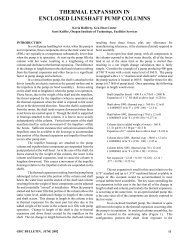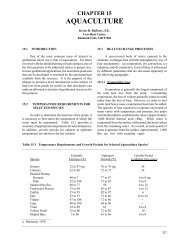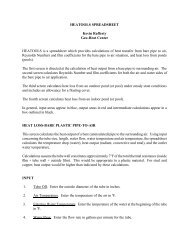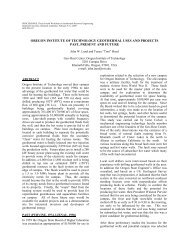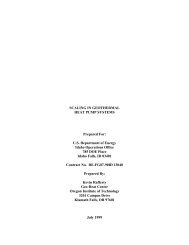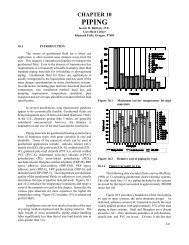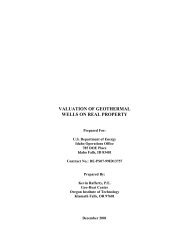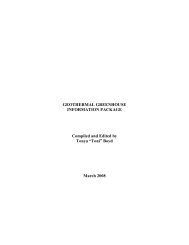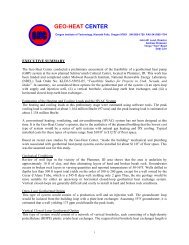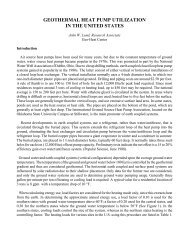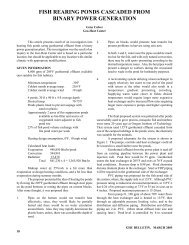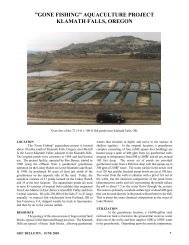Companion Study Guide on Short Course on Geothermal ... - OSTI
Companion Study Guide on Short Course on Geothermal ... - OSTI
Companion Study Guide on Short Course on Geothermal ... - OSTI
Create successful ePaper yourself
Turn your PDF publications into a flip-book with our unique Google optimized e-Paper software.
4.0 CORROSION ENGINEERING FOR LOW-TEMPERATURE GEOTHERMAL<br />
SYSTEMS<br />
4.1 Performance of Materials<br />
Carb<strong>on</strong> Steel<br />
For many years, the Ryznar Index (discussed in the Appendix), has been used to estimate the<br />
corrosivity and scaling tendencies of potable water supplies. However, the statistical study discussed<br />
in Secti<strong>on</strong> 3 found no significant correlati<strong>on</strong> (at the 95 percent c<strong>on</strong>fidence level) between carb<strong>on</strong> steel<br />
corrosi<strong>on</strong> and Ryznar Index. Therefore, the Ryznar Index, and other indices based <strong>on</strong> calcium<br />
carb<strong>on</strong>ate saturati<strong>on</strong>, should not be used to predict corrosi<strong>on</strong>. The Ryznar Index may be predictive<br />
of calcium carb<strong>on</strong>ate scaling tendencies.<br />
Table 2 summarizes the expected performance of carb<strong>on</strong> steel in Class Va geothermal fluids.<br />
Under these c<strong>on</strong>diti<strong>on</strong>s, corrosi<strong>on</strong> rates of about 5 to 20 mpy can be expected, often with severe<br />
pitting.<br />
Table 3 summarizes the expected performance of carb<strong>on</strong> steel in Class Vb geothermal fluids.<br />
Carb<strong>on</strong> steel piping has given good service in a number of systems, provided the system design<br />
rigorously excludes oxygen. However, introducti<strong>on</strong> of 30 ppb oxygen under turbulent flow<br />
c<strong>on</strong>diti<strong>on</strong>s causes a four-fold increase in uniform corrosi<strong>on</strong>. Saturati<strong>on</strong> with air often increases the<br />
corrosi<strong>on</strong> rate at least 15-fold. Oxygen c<strong>on</strong>taminati<strong>on</strong> at the 50 ppb level often causes severe pitting.<br />
Chr<strong>on</strong>ic oxygen c<strong>on</strong>taminati<strong>on</strong> causes rapid failure. These fluids are characteristic of those used by<br />
Icelandic district heating systems. In those systems, steel piping has been generally successful, but<br />
carb<strong>on</strong> steel shell-and-tube heat exchangers have been satisfactory <strong>on</strong>ly in systems where 10 ppm<br />
excess sodium sulfite is added c<strong>on</strong>tinuously as an oxygen scavenger.<br />
In the case of buried steel pipe, it is critical that the external surfaces be protected from<br />
c<strong>on</strong>tact with groundwater. Such groundwater is aerated, and has caused pipe failures by external<br />
corrosi<strong>on</strong> in a least two U.S. systems. Required external protecti<strong>on</strong> can be obtained by use of<br />
coatings or pipe-wrap, provided the selected material will resist the system operating temperatures<br />
and thermal stresses.<br />
At temperatures above 135 o F, galvanizing (zinc coating) will not protect steel from either<br />
geothermal or groundwater.<br />
Hydrogen sulfide inhibits the reacti<strong>on</strong> of atomic hydrogen <strong>on</strong> the steel surface, itself a product<br />
of the prot<strong>on</strong> reducti<strong>on</strong> step of the corrosi<strong>on</strong> processes, to form molecular hydrogen. The atomic<br />
hydrogen enters the steel lattice and, in the case of carb<strong>on</strong> (mild) steels, accumulates as molecular<br />
hydrogen in microvoilds, causing hydrogen blistering. Hydrogen blistering can be prevented by use<br />
of vold-free, or “killed” steels.



